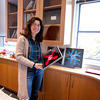When a fluid-immersed array of supported plates or pillars is dried, evaporation leads to the formation of menisci on the tips of the plates or pillars that bring them together to form complex patterns. Building on prior experimental observations, we use a combination of theory and computation to understand the nature of this instability and its evolution in both the two- and three-dimensional setting of the problem. For the case of plates, we explicitly derive the interaction torques based on the relevant physical parameters associated with pillar deformation, contact-line pinning/depinning and fluid volume changes. A Bloch-wave analysis for our periodic mechanical system captures the window of volumes where the two-plate eigenvalue characterizes the onset of the coalescence instability. We then study the evolution of these binary clusters and their eventual elastic arrest using numerical simulations that account for evaporative dynamics coupled to capillary coalescence. This explains both the formation of hierarchical clusters and the sensitive dependence of the final structures on initial perturbations, as seen in our experiments. We then generalize our analysis to treat the problem of pillar collapse in three dimensions, where the fluid domain is completely connected and the interface is a minimal surface with the uniform mean curvature. Our theory and simulations capture the salient features of experimental observations in a range of different situations and may thus be useful in controlling the ensuing patterns.
2015
. Elastocapillary coalescence of plates and pillars. Proc. R. Soc. A. 2015;471 (2175) :20140593.Abstract
. Role of Flagella in Adhesion of Escherichia coli to Abiotic Surfaces. Langmuir. 2015;31 (22) :6137-6144. Full TextAbstract
. Designing a gel–fiber composite to extract nanoparticles from solution. Soft Matter. 2015;11 (44) :8692-8700.Abstract
George Ledlie Prize awarded to Joanna Aizenberg
. Multifunctionality of chiton biomineralized armor with an integrated visual system. Science. 2015;350 (6263) :952-956. Full TextAbstract
An aptamer-functionalized chemomechanically modulated biomolecule catch-and-release system. Nat. Chem. 2015;7 (5) :447-454. Full TextAbstract
. Color from hierarchy: Diverse optical properties of micron-sized spherical colloidal assemblies. Proc. Nat. Acad. Sci. 2015;112 (35) :10845-10850. Publisher's VersionAbstract
Stability of Surface-Immobilized Lubricant Interfaces under Flow. Chem. Mater. 2015;27 (5) :1792-1800. Full TextAbstract
. New functional insights into the internal architecture of the laminated anchor spicules of Euplectella aspergillum. Proc. Nat. Acad. Sci. 2015;112 (16) :4976-4981. Publisher's VersionAbstract
. Dynamic polymer systems with self-regulated secretion for the control of surface properties and material healing. Nat. Mater. 2015;14 (8) :790-795. Publisher's VersionAbstract
Liquid-Infused Silicone As a Biofouling-Free Medical Material. ACS Biomater. Sci. Eng. 2015;1 (1) :43-51.Abstract
. Dynamics of evaporative colloidal patterning. Physics of Fluids. 2015;27 (9) :092105. Full TextAbstract
. Liquid-based gating mechanism with tunable multiphase selectivity and antifouling behaviour. Nature. 2015;519 (7541) :70-73. Full TextAbstract
